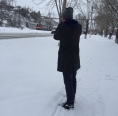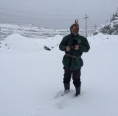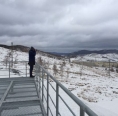-

SWISS MEDIA ARTIST HAS PAINTED SATKA FOR A NEW ART PROJECT
-
Address:
Satka
-
Partners:
Last week, a famous Swiss media artist Peter Aerschmann worked in Satka of the Chelyabinsk Region.
The visit was dedicated to opening of his personal exhibition that took place in the updated Magnezit Museum November 7, 2016. Let us remind you that Peter Aerschmann has been engaged in art video and photo practices for more than 20 years. Aerschmann images are a computer collage, where objects meet textures, and stories meet fates. All videos have been created and are demonstrated mute: this requires spectators’ ultimate concentration on the image. In Satka’s exhibition, the spectators watched extracts from 20 works created since 2008 until 2015.
In addition to presentation of his exhibition and communication with spectators, Peter Aerschmann had another, more creative goal to visit Satka – to gather content for new works. During several days, the artist examined operations of the backbone enterprise, Magnezit industrial complex. Here, he visited Karagajsky and Berezovske open pits, went down the mine and paid a lot of attention to the grain magnesite firing house. Besides, the Swiss artist visited the Department of Technology Developments, where he was told of the processes and methods employed by Satka researchers. Aerschmann’s attention was also drawn by the machinery and repair enterprise, magnesian products workshop, rotating furnaces and garage for heavy road vehicles. The artist shot virtually every his step made along the enterprise, as, according to him, he had never been to the enterprise as large as Magnezit.
Satka’s urban space was also shot by Aerschmann: internal and external design of Magnezit Cultural Center, the surrounding park and the 19th quarter, downtown and Olymp football fields, Khrushchev-era and modern buildings, children’s playgrounds. By the way, the latter, from different countries and cities, make up a peculiar collection of Peter Aerschmann that so far he had not used for creative purposes.
Sharing his impressions from Satka and Ural the artist has noted that the city is very similar to Switzerland – by its nature, characters and even local cuisine.
-
26.08 - 26.08
DIARY OF THE THIRD INDUSTRIAL BIENNALE
-
28.11 - 28.11
MY SATKA FESTIVAL WINS THE CONTEST OF CORPORATE VOLUNTEER PROJECTS
-
13.10 - 15.10
COOPERATION WITH VGIBL NAMED AFTER M.I. RUDOMINO





